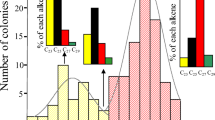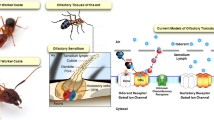Abstract
There are two separate, and presumably opposing, processes that affect colony odor in the desert ant Cataglyphis niger: (1) biosynthesis and turnover of these chemicals by individual ants, and (2) homogenization of colony odor through exchange of cues. The first increases signal variability; the latter decreases it. The impact of these factors was tested by splitting colonies and monitoring the profile changes occurring in the postpharyngeal glands (PPG) and cuticular hydrocarbons.
From each of two polygynous nests four daughter colonies were formed, three monogynous and one queenless. Thereafter, 10 ants from each were randomly selected each month, for three successive months, for analyses of their PPG and cuticular hydrocarbons. From two colonies we also obtained ants from a known matriline. Over time, there was a shift in hydrocarbon profiles of both the PPG and cuticular washes in each of the tested colonies. Moreover, by subjecting selected hydrocarbon constituents to a discriminant analyses based on their relative proportions, all of the daughter colonies (queenright and queenless) were distinguishable from each other and from their respective mother colonies. In each of the queenright daughter colonies, the queen profile was indiscriminable from that of the workers and often was in the center of the group. Full sisters were clearly distinguishable from their nestmates, emphasizing the genetic versus environmental processes that govern colony odor. The effect of time was always superior to the separation effect in contributing to odor segregation. Comparison of the Mahalanobis distances indicated that the shift in hydrocarbon seems to proceed along parallel lines rather than in divergence. However, there was no overt aggression between ants that originated from the different subgroups in dyadic encounters. It appears that in this species a three-month separation period is not sufficient to change the hydrocarbon profile beyond the recognition threshold.
Similar content being viewed by others
REFERENCES
BAGNÈRES, A. G., and MORGAN, E. D. 1991. The postpharyngeal glands and the cuticle of Formicidae contain the same characteristic hydrocarbons. Experientia 47:106-111.
BAGNÈRES, A. G., KILLIAN, A., CLéMENT, J. L., and LANGE, C. 1991. Interspecific recognition among termites of the genus Reticulitermes: Evidence for a role for the cuticular hydrocarbons. J. Chem. Ecol. 17:2397-2420.
BONAVITA-COUGOURDAN, A., CLéMENT, J. L., and LANGE, C. 1987a. Nestmate recognition: The role of cuticular hydrocarbons in the ant Camponotus vagus Scop. J. Entomol. Sci. 22:1-10.
BONAVITA-COUGOURDAN, A., CLÈMENT, J. L., and LANGE, C. 1987b. Subcaste discrimination in the ant Camponotus vagus Scop., p. 475, in J. Eder and H. Rembold (eds.). Chemistry and Biology of Social Insects. Proceedings of the Tenth International Congress of the International Union for the Study of Social Insects, Munich, 1986. Verlag J. Peperny, Munich.
BONAVITA-COUGOURDAN, A., CLÈMENT, J. L., and LANGE,C. 1993. Functional subcaste discrimination (foragers and brood-tenders) in the ant Camponotus vagus Scop.: Polymorphism of cuticular hydrocarbon patterns. J. Chem. Ecol. 19:1461-1477.
BOULAY, R., HEFETZ, A., SOROKER V., and LENOIR, A. 2000. Camponotus fellah colony integration: Worker individuality necessitates frequent hydrocarbon exchanges. Anim. Behav. 59:1127-1133.
CROZIER, R. H., and DIX, M. W. 1979. Analysis of two genetic models for the innate components of colony odour in social Hymenoptera. Behav. Ecol. Sociobiol. 4:217-224.
DAHBI, A., and LENOIR, A. 1998. Nest separation and dynamics of the Gestalt odor in the polydomous ant Cataglyphis iberica (Hymenoptera, Formicidae). Behav. Ecol. Sociobiol. 42:349-355.
DAHBI, A., CERDá, X., HEFETZ, A., and LENOIR, A. 1997. Adult transport in the ant Cataglyphis iberica: A means to maintain a uniform colonial odour in a species with multiple nests. Physiol. Entomol. 22:13-19.
DAHBI, A., HEFETZ, A., CERDA, X., and LENOIR, A. 1999. Trophallaxis mediates uniformity of colony odor in Cataglyphis iberica ants (Hymenoptera, Formicidae). J. Insect Behav. 12:559-567.
HEFETZ, A., ERRARD, C., CHAMBRIS, A., and LE NÈGRATE, A. 1996. Postpharyngeal gland secretion as a modifier of aggressive behavior in the myrmicine ant Manica rubida. J. Insect Behav. 9:709-717.
LAHAV, S., SOROKER, V., HEFETZ, A., and VANDER MEER, R. K. 1999. Direct behavioral evidence for hydrocarbons as ant recognition discriminators. Naturwissenschaflen 86:246-249.
LENOIR, A., CUISSET, D., and HEFETZ A. 2001. Effects of social isolation on hydrocarbons pattern and nestmate recognition in the ant Aphaenogaster senilis. Insectes Soc. In press.
LIEBIG, J., PEETERS, C., OLDHAM, N. J., MARKSTADTER, C., and HOLLDOBLER, B. 2000. Are variations in cuticular hydrocarbons of queens and workers a reliable signal of fertility in the ant Harpegnathos saltator? Proc. Natl. Acad. Sci. U.S.A. 97:4124-4131.
MESKALI, M., BONAVITA-COUGOURDAN, A., PROVOST, E., BAGNÈRES, A. G., DUSTICIER, G., and CLéMENT, J. L. 1995. Mechanism underlying cuticular hydrocarbon homogeneity in the ant Camponotus vagus (Scop.) (Hymenopetra: Formicidae): Role of postpharyngeal glands. J. Chem. Ecol. 21:1127-1148.
PROVOST, E., RIVIERE, G., ROUX, M., MORGAN, E. D., and BAGNÈRES, A. G. 1993. Change in the chemical signature of the ant Leptothorax lichtensteini Bondroit with time. Insect. Biochem. Mol. Biol. 23:945-957.
SOROKER, V., and HEFETZ, A. 2000. Hydrocarbon site of synthesis and circulation in the desert ant Cataglyphis niger. J. Insect Physiol. 46:1097-1102.
SOROKER, V., VIENNE, C., HEFETZ, A., and NOWBAHARI, E. 1994. The postpharyngeal gland as a “gestalt” organ for nestmate recognition in the ant Cataglyphis niger. Naturwissenschaflen 81:510-513.
SOROKER, V., HEFETZ, A., COJOCARU, M., BILLEN, J., FRANKE, S., and FRANCKE, W. 1995a. Structural and chemical ontogeny of the postpharyngeal gland in the desert ant Cataglyphis niger. Physiol. Entomol. 20:323-329.
SOROKER, V., VIENNE, C., and HEFETZ, A. 1995b. Hydrocarbon dynamics within and between nestmates in Cataglyphis niger (Hymenoptera, Formicidae). J. Chem. Ecol. 21:365-378.
VANDER MEER, R., SALIWANCHIK, D., and LAVINE, B. 1989. Temporal changes in colony cuticular hydrocarbon patterns of Solenopsis invicta. Implications for nestmate recognition. J. Chem. Ecol. 15:2115-2125.
VAUCHOT, B., PROVOST, E., BAGNÈRES, A. G., and CLéMENT, J. L. 1996. Regulation of the chemical signatures of two termite species, Reticulitermes santonensis and Reticulitermes lucifugus grassei, living in mixed experimental colonies. J. Insect Physiol. 42:309-321.
VAUCHOT, B., PROVOST, E., BAGNÈRES, A. G., RIVIÈRE, G., ROUX, M., and CLéMENT, J. L. 1998. Differential adsorption of allospecific hydrocarbons by cuticles of two termite species, Reticulitermes santonensis and R. lucifugus grassei, living in mixed colony. J. Insect Physiol. 44:59-66.
YAMAOKA, R., and KUBO, H. 1990. Identity of cuticular hydrocarbon profile among workers of the ant which is maintained by the presence of the queen would be the nestmate recognition cue. pp. 406-407, in G. K. Veeresh, B. Mallik and C. A. Viraktamath (eds.). Social Insects and the Environment: Proceeding of the 11th International Congress of the IUSSI. Oxford & IBH Publishing, New Delhi.
Author information
Authors and Affiliations
Rights and permissions
About this article
Cite this article
Lahav, S., Soroker, V., Meer, R.K.V. et al. Segregation of Colony Odor in the Desert Ant Cataglyphis niger. J Chem Ecol 27, 927–943 (2001). https://doi.org/10.1023/A:1010382919227
Issue Date:
DOI: https://doi.org/10.1023/A:1010382919227




